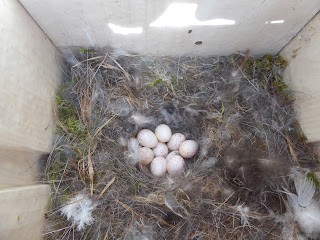Date: 22-4-2018
Nets: 105m – new
summer configuration
Music: none
Weather: slight
breeze, 15°C at start rising to 27°C at end
Ringers: CS and EB
|
Species
|
Ringed
|
Re-trapped
|
Total
|
|
Blackcap
|
4
|
2
|
6
|
|
Blue
Tit
|
|
1
|
1
|
|
Chaffinch
|
2
|
3
|
5
|
|
Firecrest
|
1
|
|
1
|
|
Long-tailed
Tit
|
|
1
|
1
|
|
Pied
Flycatcher
|
2
|
2
|
4
|
|
Robin
|
|
2
|
2
|
|
Song
Thrush
|
|
1
|
1
|
|
Willow
Warbler
|
1
|
|
1
|
|
Wood
Warbler
|
1
|
|
1
|
|
Wren
|
1
|
|
1
|
|
Total
|
12
|
12
|
24
|
Wow! What a change!
So quick! They were CS’s response on returning to Meisen Wood after a
week away visiting friends.
In that brief
interlude life had vigorously burst forth from its winter dormancy into an
eruption of colour. Deciduous trees and
bushes had become dressed in freshly emergent light green leaves; several trees
were now draped with white and pink blossoms; the meadow had been transformed
from dull brown to a vibrant green liberally sprinkled with numerous colourful
flowers; and the air was buzzing with insects.
This sudden flourishing of life, this great release of latent energy, contributes
to making spring an exciting season.
Setting the nets in
the pre-dawn light to the accompaniment of an increasingly loud dawn chorus was
a delight and accentuated our sense of anticipation of a good morning’s
ringing. Our anticipation was not for a
large catch but for a session that would hopefully include some returning, and
passage migrants. We were not
disappointed.
At supper, last night,
we had chatted about the new net configuration which has been forced upon us by
last winter’s storms toppling eighteen pine trees. Potentially a positive consequence of this
aeolian destruction has been the creation of some new open areas; such changes
are a natural part of woodland ecology and thus would we experience, in the
short and long term, a change in the species we catch. This is something we look forward to
monitoring. We also talked about Wood
Warbler saying we normally hear a few singing and calling in the canopy from
about now to mid-May when they disappear and never deign to enter our nets.
Well blow us down
there was irony in the first net round! In
a net set by a newly opened area, in the lowest pocket was a Wood Warbler! A cracking little bird with a mossy-green
back, a beautiful yellow throat and upper breast sharply delineated from a pure
white belly. Pure delight, what shall we
try and wish for next!?

Today’s captures
included four Pied Flycatchers: two new and two re-traps. The two re-traps were from last weekend when
we had squeezed in a session before CS went off travelling. During that session we had also put up six
additional nest boxes as part of a cunning plan to encourage more Pied
Flycatchers to breed in Meisen Wood. The
thinking behind the scheming being: hopefully by now the resident Blue and
Great Tits have established their territories and claimed the nest boxes
they’ll use. Therefore the new nest
boxes will be available for arriving Pied Flycatchers. Sounds great in theory but like most of our
cunning plans for birds will it do it’s usual, and fail? O, um……; we’ll see!
The Pied Flycatchers
and the Song Thrush have arrived late this year. Normally we catch our first Song Thrush in
late March. And in the last three years
have consistently caught our first Pied Flycatcher on April 6th in
the same net – there’s consistency for you.
Late seems to be this spring’s theme.
So far we have seen few swallows and no House or Sand Martins. Similarly in the three local areas where we
monitor breeding Curlew, Lapwing and Black-tailed Godwit they all arrived late
and in lower, than normal, numbers. The
Black-tailed Godwits are only just arriving and starting their attractive
display flights. Hopefully this is a
consequence of poor weather and not some calamitous event at their wintering,
or passage, areas!
The Song Thrush maybe
late but it seemed to be ready to breed as, to quote EB, “It’s got a stonking
great CP!” Translation: it has a large
cloacal protuberance. A cloacal
protuberance is not quite a penis though it is the avian equivalent in that it
is used in insemination. Cloacal
protuberance size varies with species and seasonally: large during the breeding
season; much reduced, almost absent, when not required, in the winter.
A final tally of 24 birds is typical for Meisen Wood in late April. This number will decline further, such that
by mid-July a15 bird session will be considered to be good. Is it worth the effort? Yes, as it is an
integral part of population and ecological monitoring to which bird ringing
contributes. Such a decline is natural
in woodland where the birds require quite large territories to secure their
needs, and those of their young; food particularly is not as abundant, unlike
in reed-beds where there are multiple hatches of insects. But come late summer with breeding completed
and the trees’ fruiting the bird numbers will increase again.
Chris











